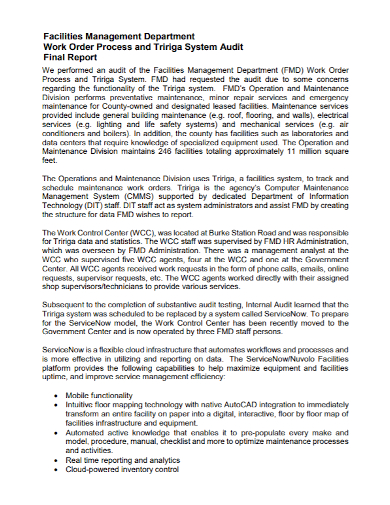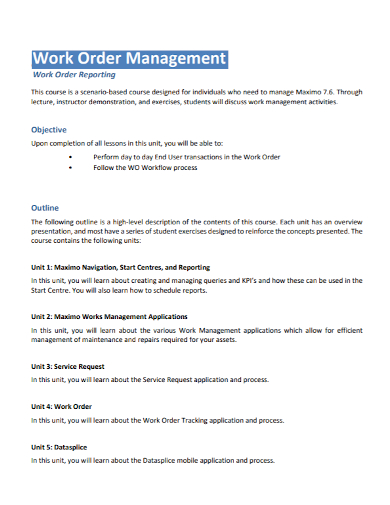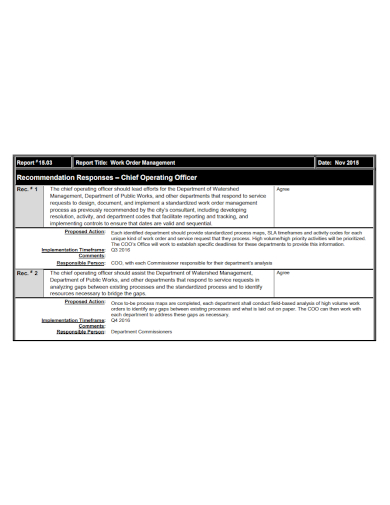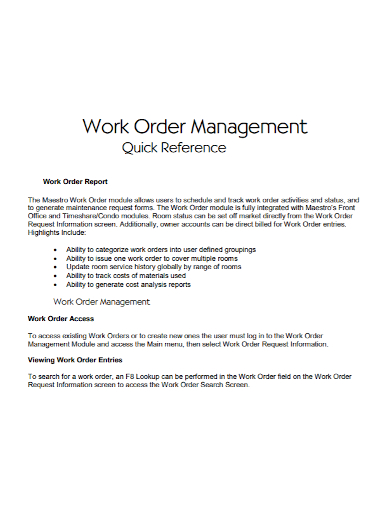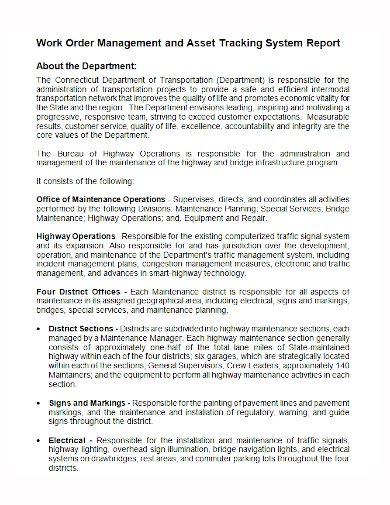In large manufacturing plant companies which produces a large number of products and at some instances has a sizable workforce, a work order management report is essential to keep track of the amount of work being done. This type of report is important to those in the manufacturing industries because this can be used to track all of tasks as they are created, executed, closed, and more. Read more about this in our article and for templates, check out our work order management report samples below:
5+ Work Order Management Report Samples
1. Work Order Management Final Report
2. Work Order Management Report
3. Work Order Management Recommendation Report
4. Work Order Management System Project Report
5. Work Order Management Access Report
6. Work Order Management Asset System Report
What Is a Work Order Management Report?
First of all a work order management is standardized approach of processing and completing maintenance work orders in a timely manner in order to minimize any delays. Work order completion depends on the availability of other maintenance resources such as assets, parts, people, and money. Simply put it can be defined as the proper and timely processing of work orders. Work requests can be submitted to maintenance by any of their many types of customers and staff, depending on the type of business, industry, and facility being managed. Whereas a work order management report is a comprehensive document that outlines work orders by plant, customer and item. It also displays production sequence, inventory and capacity statuses. These reports are used by production managers to determine the priority and sequence of the products they manufacture.
How To Create a Work Order Management Report?
Without a proper work order management report, it would be difficult for production and manufacturing companies to meet the demands of their clients. More so, work order management reports will enable managers identify upcoming issue related to inventory shortage or manufacturing capacity. A format of a work order management reports may differ depending on a company but it has the overall components of the following:
Work Order Summary
A work order summary contains the description of the task or need and the name of requesting department or individual. It also includes the work order status, the current assigned to, the requester, days aged, labor hours, total costs and more. It can also be grouped by location, craft, purpose, assigned to, etc. whichever fits your company’s work order management process and provide you with a total for each grouping as well as a grand total.
I. Purpose Summary
The purpose summary section is used for tracking and reporting how resources (monetary, time, etc.) have been allocated based on the reason why requests were entered into the system. This breaks down the number of work orders dedicated to each purpose code tracked by your organization.
II. Location
This section will include location of activities such as name of facility, or name of area within a facility. Which includes the total labor hours and labor costs, material costs, and a total cost by facility. Here you are able to assess how resources (monetary, time, etc.) have been allocated to each location by providing line item results for each facility.
III. Employee/Workers Report
This will include name of person or team to complete the task this may be in-house resource or third party. Here you will be able to manage and track the work load of each of your employees or any third party partners. Since this will provide a systematic breakdown of each employee and the total number of hours they’ve tracked for the given reporting period. The report also includes the average number of hours each employee enters per work order, the average number of days it takes them to complete a work order, as well as the total number of work orders they worked on during the time period identified.
IV. Activity Details
Encoded in this section is the description of the task or need, the name of requesting department or individual and estimated completion date. For every transaction returned on the report, the report provides the transaction type, transaction description, quantity, and costs.
V. Craft Summary
The craft summary portion includes the number of hours that have been dedicated to each craft, the number of work orders per craft, and the cost for labor and materials. The report also includes some great additional information: the average hours, cost per work order, and the total percentage of work each craft accounts for.
FAQs
What Is the Difference between Purchase Order and Work Order?
Purchase order deals with the products, services or items whereas work order is about man power that deals with labor and task.
What Is an Order Form?
An order form indicates the quotation of a service or product to be rendered by the seller. This is a document that buyers submit to sellers when requesting products or services.
What Is Workflow Management?
A workflow management is managing and streamlining workflows for optimal output. Cutting off redundant task and provides an infrastructure for the set-up, performance and monitoring of a defined sequence of tasks, arranged as a workflow application.
Overall, to ensure the steady and well coordinated work flow process of industries that specializes in manufacturing and production, a well-executed work order management report can help aid companies and employees in their tasks.
Related Posts
FREE 9+ Employee Payroll Report Samples
FREE 9+ Work Order Form Samples
FREE 9+ Management Analyst Job Description Samples
FREE 8+ Property Risk Management Samples
FREE 7+ Sample Time Management
FREE 7+ Construction Field Report Samples
Critical Skills Every Project Manager Should Have
FREE 3+ Sample Contractor Work Order Forms
FREE 22+ Sample Inventory Reports
FREE 17+ Sample Management Reports
FREE 10+ Monthly Progress Report Samples
FREE 10+ Monthly Accomplishment Report Samples
FREE 10+ Distribution Report Samples
FREE 10+ Work Investigation Report Samples
FREE 10+ Monthly Business Report Samples

